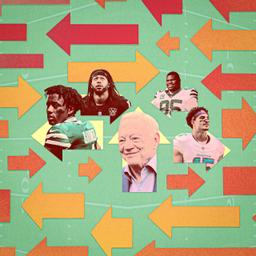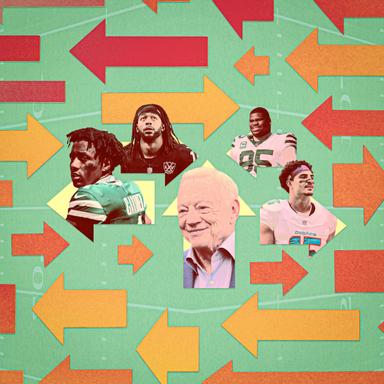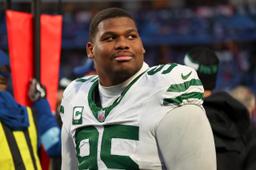
We should have known that Colts general manager Chris Ballard was feeling himself when it leaked that Indianapolis wanted to sign Daniel Jones to a long-term contract. It seems Ballard already considers Jones to be his quarterback of the future—and he gave us a much clearer signal of that on Tuesday when he traded two first-round picks and receiver Adonai Mitchell to the Jets for star cornerback Sauce Gardner. This isn’t just a win-now move; it’s easily the most aggressive move the typically conservative Ballard has ever made.
Ballard covets his first-round picks. He’d previously given up first-round picks for players only twice since he became the Colts’ general manager in 2017: in 2020, when he sent one to San Francisco for DeForest Buckner, and in 2021, when he gave up a conditional first and a third-rounder in the regrettable Carson Wentz trade. He’s traded up in the draft only a handful of times, and never for a day-one pick. Most of Ballard’s moves have been made to add draft capital. Trading two first-round picks for a cornerback goes against his general team-building philosophy—and suggests that the team’s 7-2 start and what Ballard’s seen out of Jones have shifted his thinking.
Prior to this trade, the Rams were the last team to trade two firsts for a cornerback. They gave them up (along with a fourth-rounder) for Jalen Ramsey in a midseason swap with the Jaguars. That was the height of the “fuck them picks” era in Los Angeles, when general manager Les Snead traded away his first-round picks in six consecutive drafts. That approach ultimately helped Snead’s Rams win a Super Bowl after the 2021 season, with many of their notable trade acquisitions playing a big role, including Ramsey. A number of those moves, as well as the entire pickless philosophy, were questioned before Los Angeles lifted the Lombardi Trophy. In the NFL, win-now moves are rarely the result of good process and long-term thinking, so the only way to rationalize them is to, well, win.
If Ballard has in fact found his franchise quarterback in Jones, this trade won’t age poorly. The Colts have built a rock-solid offensive infrastructure that shouldn’t be too hard to maintain. All of their best players—save for Jones—are signed for the next few years, and they have plenty of cap space left for new additions. They’ve already filled their two most glaring roster holes by adding Jones and Gardner. Unless Jones shoots for the moon in contract negotiations, the Colts should get him at a below-market price, and they’ll also get a discount by trading for Gardner early in his contract.
Ballard can also use Gardner’s recently signed contract extension—a four-year, $120.4 million deal—as scaffolding for a new long-term (and cap-friendly) deal. This move might alter the team’s draft plans over the next two years, but it won’t blow up their salary cap situation.
Again, though, this is an optimistic way of looking at the deal, one that assumes Jones will maintain his current level of play—an assumption that feels a bit more dubious after his five-turnover performance in Sunday’s loss to Pittsburgh. Even with that setback, Jones is still on track to put up All-Pro numbers this season, and he’s producing solid film. He’s made tangible improvements in his play since even his best season with the Giants in 2022, and he’s shown a mastery of Shane Steichen’s scheme in his first year in the building. As long as the Colts don’t ask Jones to elevate the guys around him, this is a job he’s suited for.
It goes without saying that Gardner’s performance will also dictate the success of the trade for the Colts, who were desperate for help at the cornerback position. Charvarius Ward has missed the past three games with a concussion that landed him on injured reserve. Xavien Howard started the first four games of the season but then abruptly retired. Jaylon Jones has been dealing with a hamstring injury. So Gardner fills a huge void just by being on the field.
To make this trade worth the high cost, though, Gardner will have to play like a lockdown corner who can shadow star receivers all over the field and hold up in man coverage. Denver has one of those guys in reigning Defensive Player of the Year Patrick Surtain II. Houston has another in Derek Stingley Jr. That might be the extent of the list. Gardner has the ability to join those two in the elite tier, but he hasn’t fully shown it yet. What Gardner is able to do is stick tight to receivers in coverage. Per Next Gen Stats, he’s forced a tight-window throw on 83.3 percent of his targets when in man coverage. That leads the NFL. But Gardner has also had some unfortunate moments at the catch point. Both of the touchdowns he’s given up this season were in tight coverage. He lost this hand-fighting battle with George Pickens in a Week 5 loss to Dallas:
And Darren Waller skied over him for a contested catch touchdown in a Week 4 loss in Miami:
Other than those two plays, Gardner hasn’t given up much. And Jets coach Aaron Glenn was asking him to play more man coverage than he was used to under former coach Robert Saleh. Plus, Gardner was almost always shadowing the opponent’s top receiver; he faced matchups against Pickens, DK Metcalf, and Mike Evans. He held his own against all of them.
If you’re wondering why the Colts were so keen to bring in a cover corner like Gardner, look no further than Indy’s first loss of the season back in late September, when Puka Nacua torched the secondary for 170 yards on 13 catches. Indianapolis couldn’t find an answer for him, whether it was tight man coverage with Howard or zone coverage with a safety lurking over the top. Defensive coordinator Lou Anarumo is known as a great game planner, but you can’t scheme around such a talent disadvantage. That’s the kind of problem that can pop up in the playoffs, and Indianapolis was woefully unprepared for the challenge. The Colts needed a dude in the secondary. Surtain and Stingley weren’t available, so they got the next best guy.
Whether that will ultimately move the needle for the Colts defense as a whole is questionable. I’d be more optimistic about this working out in the short term if the team didn’t have issues elsewhere. The pass rush is generating a league-average sack rate and a below-average pressure rate. This trade won’t do much to improve those numbers—though, in theory, good coverage does give the pass rush more time to get home. And now the team has less draft capital to throw at that problem in the future. If the goal of this trade was to add a talented player to the roster and turn a mediocre defense into an above-average one, the Colts succeeded. If the goal is to turn this into a top-10 unit that can lead a championship run right away, more moves are necessary.
But that’s also fine. If Ballard believes he has the quarterback in place to justify an accelerated roster upgrade, then trading for Gardner won’t be his last big swing. It can’t be. As the “fuck them picks” Rams showed us when the Ramsey trade didn’t save their 2019 season like it was intended to, you can’t fold after going all in. They traded two more first-round picks (plus a third-rounder and Jared Goff) for Matthew Stafford in 2021 and swung deadline deals for Von Miller and Odell Beckham Jr. before finally winning a title. If the first big bet isn’t enough, you find even more chips to push into the middle of the table until you get over the hump. Ballard’s bets on Jones and Gardner won’t be judged by draft capital formulas or salary cap space. They’ll be judged on wins. If the Colts keep stacking them, nobody will take issue with how the team was built.






